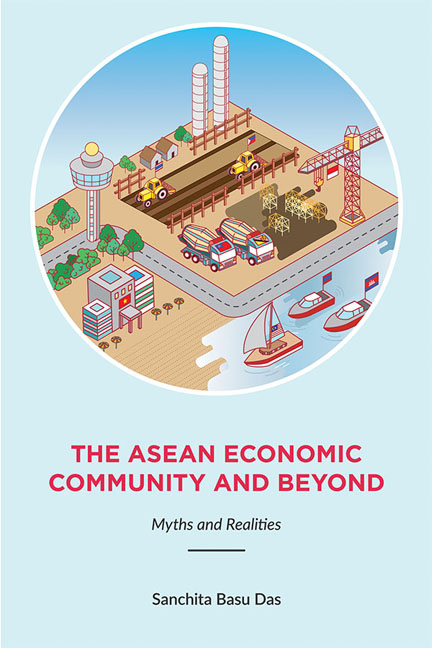Book contents
- Frontmatter
- Dedication
- Contents
- Foreword
- Acknowledgements
- Abbreviations
- 1 Introduction: The ASEAN Economic Community and Beyond
- I THE ASEAN ECONOMIC COMMUNITY (AEC)
- II BEYOND THE ASEAN ECONOMIC COMMUNITY
- 9 The Regional Comprehensive Economic Partnership: Going Beyond ASEAN+1 FTAs
- 10 Comparing ASEAN+1 FTAs for an Effective RCEP
- 11 Challenges in Negotiating the Regional Comprehensive Economic Partnership Agreement
- 12 The Next Decade in ASEAN-U.S. Economic Relations
- 13 RCEP and TPP: Comparisons and Concerns
- 14 The Trans-Pacific Partnership (TPP): Economic and Strategic Implications for the Asia-Pacific
- 15 The Trans-Pacific Partnership as a Tool to Contain China: Myth or Reality?
- 16 RCEP and TPP: Can They Converge into an FTAAP?
- 17 Is APEC's Relevance Fading?
- III AN ASEAN PERSPECTIVE OF REGIONAL CONNECTIVITY
- Appendix: Summary of the Trans-pacific Partnership Agreement
- Index
- About the Author
10 - Comparing ASEAN+1 FTAs for an Effective RCEP
from II - BEYOND THE ASEAN ECONOMIC COMMUNITY
Published online by Cambridge University Press: 19 May 2017
- Frontmatter
- Dedication
- Contents
- Foreword
- Acknowledgements
- Abbreviations
- 1 Introduction: The ASEAN Economic Community and Beyond
- I THE ASEAN ECONOMIC COMMUNITY (AEC)
- II BEYOND THE ASEAN ECONOMIC COMMUNITY
- 9 The Regional Comprehensive Economic Partnership: Going Beyond ASEAN+1 FTAs
- 10 Comparing ASEAN+1 FTAs for an Effective RCEP
- 11 Challenges in Negotiating the Regional Comprehensive Economic Partnership Agreement
- 12 The Next Decade in ASEAN-U.S. Economic Relations
- 13 RCEP and TPP: Comparisons and Concerns
- 14 The Trans-Pacific Partnership (TPP): Economic and Strategic Implications for the Asia-Pacific
- 15 The Trans-Pacific Partnership as a Tool to Contain China: Myth or Reality?
- 16 RCEP and TPP: Can They Converge into an FTAAP?
- 17 Is APEC's Relevance Fading?
- III AN ASEAN PERSPECTIVE OF REGIONAL CONNECTIVITY
- Appendix: Summary of the Trans-pacific Partnership Agreement
- Index
- About the Author
Summary
ASEAN adopted the Regional Comprehensive Economic Partnership (RCEP) framework in November 2011, with an ambition to join its ten members with six nations — Australia, China, India, Japan, Korea and New Zealand — that are currently enjoying five separate FTAs with the grouping. The participating countries are aiming for a modern, comprehensive, high-quality and mutually beneficial FTA. Although currently, ASEAN has five “plus one” FTAs, they are significantly different from each other. First, the five FTAs were signed in different time periods. They differ from each other in terms of way of negotiation and economic coverage. Second, the tariff elimination coverage is also different: while six ASEAN states have committed to eliminate tariffs in more than 90 per cent of the products, the rest have committed to between 80 and 90 per cent. For FTA partners other than India, all have committed to eliminate more than 90 per cent of tariff lines vis-à-vis ASEAN. The end-year for each ASEAN+1 FTAs’ tariff elimination is different, making it an important consideration for RCEP negotiation. Third, there are four major methods of origin determination used in the various ASEAN plus one FTAs: Wholly obtained, Regional Value Content, Change in Tariff Classification and Specific Process Rule. The services chapter of existing ASEAN+1 FTAs is still in its early stage of development.
The RCEP is expected to address most of these differences in ASEAN+1 FTAs. The RCEP, if successfully negotiated, is likely to generate a GDP of US$26.2 trillion (32 per cent of the world), effecting about 3.5 billion people (48 per cent of the world population). It will further entrench ASEAN Centrality and demonstrate ASEAN's capability to bring together its own ten members and external partners for economic growth, development and harmonization.
INTRODUCTION
In a significant move, ASEAN adopted the Regional Comprehensive Economic Partnership (RCEP) framework in November 2011. This will join its ten members with six nations — Australia, China, India, Japan, Korea and New Zealand — that are currently enjoying five separate FTAs with ASEAN as a whole. Since then, three ASEAN Plus Working Groups have been set up on trade in goods, services, and investment. During the November 2012 Summit, the Leaders of ASEAN+6 endorsed principles (METI 2012) that stipulate that RCEP will be a modern, comprehensive, high-quality and mutually beneficial FTA.
- Type
- Chapter
- Information
- The ASEAN Economic Community and BeyondMyths and Realities, pp. 104 - 115Publisher: ISEAS–Yusof Ishak InstitutePrint publication year: 2015



